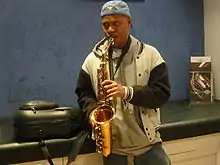Steve Coleman
Steve Coleman (born September 20, 1956)[1] is an American saxophonist, composer, bandleader and music theorist. In 2014, he was named a MacArthur Fellow.
Steve Coleman | |
|---|---|
 Steve Coleman in Paris, July 2004 | |
| Background information | |
| Birth name | Steven Douglas Coleman |
| Born | September 20, 1956 Chicago, Illinois, U.S. |
| Genres | Jazz, avant-garde, M-Base |
| Occupation(s) | Musician, composer, bandleader |
| Instrument(s) | Saxophone |
| Labels | JMT, Pangaea, Novus, BMG, Label Bleu, Pi |
Early life
Steve Coleman was born and grew up in South Side, Chicago.[1] He started playing alto saxophone at the age of 14. Coleman attended Illinois Wesleyan University for two years,.[1] followed by a transfer to Roosevelt University (Chicago Musical College).
Coleman moved to New York in 1978 and worked in big bands such as the Thad Jones/Mel Lewis Orchestra, Slide Hampton's big band, Sam Rivers' Studio Rivbea Orchestra, and briefly in Cecil Taylor's big band.[2] Shortly thereafter, Coleman began working as a sideman with David Murray, Doug Hammond, Dave Holland, Michael Brecker and Abbey Lincoln. For the first four years in New York Coleman spent a good deal of time playing in the streets and in tiny clubs with a band that he put together with trumpeter Graham Haynes, the group that would evolve into the ensemble Steve Coleman and Five Elements that would serve as the main ensemble for Coleman's activities. In this group, he developed his concept of improvisation within nested looping structures. Coleman collaborated with other young African-American musicians such as Cassandra Wilson and Greg Osby, and they founded the so-called M-Base movement.[1]
Research
Coleman regards the music tradition he is coming from as African Diasporan culture with essential African retentions, especially a certain kind of sensibility. He searched for these roots and their connections of contemporary African-American music. For that purpose, he travelled to Ghana at the end of 1993 and came in contact with (among others) the Dagomba (Dagbon) people whose traditional drum music uses very complex polyrhythm and a drum language that allows sophisticated speaking through music (described and recorded by John Miller Chernoff[3]). Thus, Coleman was animated to think about the role of music and the transmission of information in non-western cultures. He wanted to collaborate with musicians who were involved in traditions which come out of West Africa. One of his main interests was the Yoruba tradition (predominantly out of western Nigeria) which is one of the Ancient African Religions underlying Santería (Cuba and Puerto Rico), Vodou (Haiti) and Candomblé (Bahia, Brazil). In Cuba, Coleman found the group Afrocuba de Matanzas who specialized in preserving various styles of rumba as well as all in Cuba persisting African traditions which are mixed together under the general title of Santería (Abakuá, Arara, Congo, Yoruba). In 1996 Coleman along with a group of 10 musicians as well as dancers and the group Afrocuba de Matanzas worked together for 12 days, performed at the Havana Jazz Festival, and recorded the album The Sign and the Seal. In 1997 Coleman took a group of musicians from America and Cuba to Senegal to collaborate and participate in musical and cultural exchanges with the musicians of the local Senegalese group Sing Sing Rhythm. He also led his group Five Elements to the south of India in 1998 to participate in a cultural exchange with different musicians in the carnatic music tradition.
In September 2014, Coleman was awarded a MacArthur Fellowship for "refreshing traditional templates to create distinctive and innovative work in ... jazz."[4][5]
Discography
As leader
- Motherland Pulse (JMT, 1985)
- On the Edge of Tomorrow (JMT, 1986)
- World Expansion (JMT, 1987)
- Sine Die (Pangaea, 1988) – recorded in 1987–88
- Rhythm People (The Resurrection of Creative Black Civilization) (RCA Novus, 1990)
- Black Science (RCA Novus, 1991) – recorded in 1990
- Phase Space with Dave Holland (Rebel-X, 1991)
- Drop Kick (RCA Novus, 1992)
- Rhythm in Mind (Novus, 1992) – recorded in 1991
- The Tao of Mad Phat (RCA Novus, 1993)
- We Beez Like That! (InfoMatin, 1995)
- Myths, Modes and Means (BMG, 1995)
- The Way of the Cipher (BMG, 1995)
- Def Trance Beat (BMG, 1995)
- Curves of Life (BMG, 1995)
- Steve Coleman's Music: Live in Paris (BMG, 1995)
- The Sign and the Seal (BMG, 1996)
- Genesis & the Opening of the Way (BMG, 1997)
- The Sonic Language of Myth (RCA Victor, 1999)
- The Ascension to Light (BMG, 2001)
- Resistance Is Futile (Label Bleu, 2001)
- On the Rising of the 64 Paths (Label Bleu, 2002)
- Lucidarium (Label Bleu, 2004)
- Weaving Symbolics (Label Bleu, 2006)
- Invisible Paths: First Scattering (Tzadik, 2007)
- Harvesting Semblances and Affinities (Pi, 2010) – recorded in 2006–07
- The Mancy of Sound (Pi, 2011) – recorded in 2007
- Functional Arrhythmias (Pi, 2013) – recorded in 2012
- Synovial Joints (Pi, 2015) – recorded in 2014
- Morphogenesis (Pi, 2017) – recorded in 2016
- Live at the Village Vanguard Vol. I (The Embedded Sets) (Pi, 2018) – live
- Live at the Village Vanguard Vol. II (MDW NTR) (Pi, 2021) – live
As sideman
|
With Doug Hammond
With Dave Holland
With Thad Jones/Mel Lewis
With Mel Lewis
With Abbey Lincoln With Errol Parker
With The Roots
With Cassandra Wilson
|
With others
|
References
- Colin Larkin, ed. (1992). The Guinness Who's Who of Jazz (First ed.). Guinness Publishing. p. 98. ISBN 0-85112-580-8.
- Steve Coleman in: Fred Jung, My Conversation with Steve Coleman, July, 1999, M-base.com
- John Miller Chernoff, African Rhythm and African Sensibility: Aesthetics and Social Action in African Musical Idioms, 1981; CD: Master Drummers of Dagbon
- 21 Extraordinarily Creative People Who Inspire Us All: Meet the 2014 MacArthur Fellows, Macfound.org
- "Steve Coleman - MacArthur Foundation". Macfound.org. Retrieved 2020-04-22.